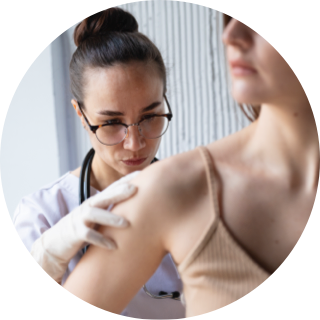Information
Almost all human viral infections are accompanied with skin symptoms. Infections of skin and mucosa caused us Herpes simplex are disseminated very much. They pass with different clinical symptoms depending on the age, localization and immunity of organism. Immunologically they are caused by two types of viruses:
І type – causing infections most often on face and upper part of body.
ІІ type – localized in genitals and sciatic area.
There are two main groups of herpes - primary and recurring.
Primary infection results in early childhood (1-5-years of age). Changes are localized in mouth mucosa /erythema/, multiple bubbles /ulceration/. Rash is accompanied with strong pain and abundant salivation. General status aggravates. Temperature is increased. After clinical healing, viruses remain in latent state in some cells and at favourable conditions for them /reduction of general and local immunity/ they are activated again and cause recurring forms of infection. Different factors play provoking role: morbid states passing with high temperature, strong neuromental tension, mechanical traumas, endocrine effect /menstruation/ and sun irradiation.
Complaints: rash appears as itching pink spot and after several hours there are groups of bubbles, filled with clear liquid which becomes turbid after several days and becomes dry, forming scabs. Total evolution lasts 10 days approximately. The so called recurring Herpes simplex genitalis is tolerated more heavily. Bubbles in it are not retained long and only erosions are noticed. Sometimes, especially in women, genital herpes could occupy big dimensions and to be accompanied with strong pains and increased temperature.
Complications in herpes, especially genital one, result when bacterial and fungal infection is added to the viral one. Clinical symptoms aggravate and antibiotic and antimycotic therapy is necessary.


 On this page, you can change your choices at any time after you have read and understood our
On this page, you can change your choices at any time after you have read and understood our